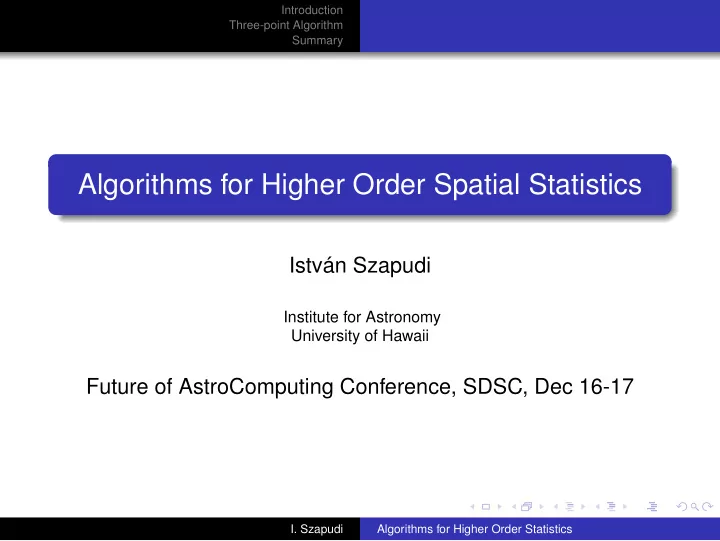

Introduction Three-point Algorithm Summary Algorithms for Higher Order Spatial Statistics István Szapudi Institute for Astronomy University of Hawaii Future of AstroComputing Conference, SDSC, Dec 16-17 I. Szapudi Algorithms for Higher Order Statistics
Introduction Three-point Algorithm Summary Outline Introduction 1 Three-point Algorithm 2 I. Szapudi Algorithms for Higher Order Statistics
Introduction Three-point Algorithm Summary Random Fields Definition A random field is a spatial field with an associated probability measure: P ( A ) D A . Random fields are abundant in Cosmology. The cosmic microwave background fluctuations constitute a random field on a sphere. Other examples: Dark Matter Distribution, Galaxy Distribution, etc. Astronomers measure particular realization of a random field (ergodicity helps but we cannot avoid “cosmic errors”) I. Szapudi Algorithms for Higher Order Statistics
Introduction Three-point Algorithm Summary Definitions The ensemble average � A � corresponds to a functional integral over the probability measure. Physical meaning: average over independent realizations. Ergodicity: (we hope) ensemble average can be replaced with spatial averaging. Symmetries: translation and rotation invariance Joint Moments F ( N ) ( x 1 , . . . , x N ) = � T ( x 1 ) , . . . , T ( x N ) � I. Szapudi Algorithms for Higher Order Statistics
Introduction Three-point Algorithm Summary Connected Moments These are the most frequently used spatial statistics Typically we use fluctuation fields δ = T / � T � − 1 Connected moments are defined recursively � � δ 1 , . . . , δ N � c = � δ 1 , . . . , δ N � − � δ 1 . . . ...δ i � c . . . � δ j . . . δ k � c . . . P With these the N -point correlation functions are ξ ( N ) ( 1 , . . . , N ) = � δ 1 , . . . , δ N � c I. Szapudi Algorithms for Higher Order Statistics
Introduction Three-point Algorithm Summary Gaussian vs. Non-Gaussian distributions These two have the same two-point correlation function or P ( k ) These have the same two-point correlation function! I. Szapudi Algorithms for Higher Order Statistics
Introduction Three-point Algorithm Summary Basic Objects These are N -point correlation functions. Special Cases Two-point functions � δ 1 δ 2 � Three-point functions � δ 1 δ 2 δ 3 � � δ N R � c = S N � δ 2 R � N − 1 Cumulants � δ N 1 δ M Cumulant Correlators 2 � c � δ ( 0 ) δ N Conditional Cumulants R � c In the above δ R stands for the fluctuation field smoothed on scale R (different R ’s could be used for each δ ’s). Host of alternative statistics exist: e.g. Minkowski functions, void probability, minimal spanning trees, phase correlations, etc. I. Szapudi Algorithms for Higher Order Statistics
Introduction Three-point Algorithm Summary Complexities Combinatorial explosion of terms N -point quantities have a large configuration space: measurement, visualization, and interpretation become complex. e.g, already for CMB three-point, the total number of bins scales as M 3 / 2 CPU intensive measurement: M N scaling for N -point statistics of M objects. Theoretical estimation Estimating reliable covariance matrices I. Szapudi Algorithms for Higher Order Statistics
Introduction Three-point Algorithm Summary Algorithmic Scaling and Moore’s Law Computational resources grow exponentially (Astronomical) data acquisition driven by the same technology Data grow with the same exponent Corrolary Any algorithm with a scaling worse then linear will become impossible soon Symmetries, hierarchical structures (kd-trees), MC, computational geometry, approximate methods I. Szapudi Algorithms for Higher Order Statistics
Introduction Three-point Algorithm Summary Example: Algorithm for 3pt Other algorithms use symmetries θ 1 θ 2 θ 3 θ 4 θθ 4 I. Szapudi Algorithms for Higher Order Statistics
Introduction Three-point Algorithm Summary Algorithm for 3pt Cont’d Naively N 3 calculations to find all triplets in the map: overwhelming (millions of CPU years for WMAP) Regrid CMB sky around each point according to the resolution Use hierarchical algorithm for regridding: N log N Correlate rings using FFT’s (total speed: 2 minutes/cross-corr) The final scaling depends on resolution N ( log N + N θ N α log N α + N α N θ ( N θ + 1 ) / 4 ) / 2 With another cos transform one and a double Hankel transform one can get the bispectrum In WMAP-I: 168 possible cross correlations, about 1.6 million bins altogether. How to interpret such massive measurements? I. Szapudi Algorithms for Higher Order Statistics
Introduction Three-point Algorithm Summary 3pt in WMAP I. Szapudi Algorithms for Higher Order Statistics
Introduction Three-point Algorithm Summary Recent Challanges Processors becoming multicore (CPU and GPU) To take advantage of Moore’s law: parallelization Disk sizes growing exponentially, but not the IO speed Data size can become so large that reading might dominate processing Not enough to just consider scaling I. Szapudi Algorithms for Higher Order Statistics
Introduction Three-point Algorithm Summary Alternative view of the algorithm: lossy compression θ 1 θ 2 θ 3 θ 4 θθ 4 I. Szapudi Algorithms for Higher Order Statistics
Introduction Three-point Algorithm Summary Compression Compression can increase processing speed simply by the need of reading less data The full compressed data set can be sent to all nodes This enables parallelization in multicore or MapReduce framework For any algorithm specific (lossy compression) is needed I. Szapudi Algorithms for Higher Order Statistics
Introduction Three-point Algorithm Summary Another pixellization as lossy compression I. Szapudi Algorithms for Higher Order Statistics
Introduction Three-point Algorithm Summary Summary Fast algorithm for calculating 3pt functions with N log N scaling instead of N 3 Approximate algorithm with a specific lossy compression phase Scaling with resolution and not with data elements Compression in the algorithm enables multicore or MapReduce style parallelization With a different compression we have done approximate likelihood analysis for CMB (Granett,PhD thesis) I. Szapudi Algorithms for Higher Order Statistics
Recommend
More recommend